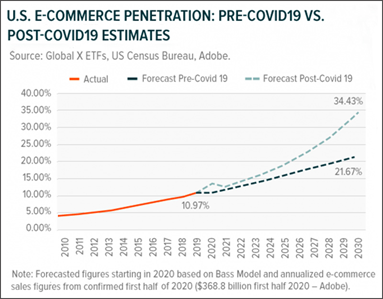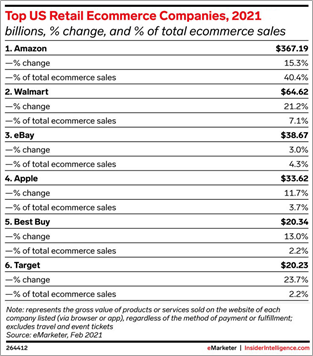The USPS’s Unmatched Logistics Network Is the Backbone of E-commerce
Global E-commerce Is Booming
Consumer behavior and technological advancements have been fueling e-commerce for years, with the value of U.S. e-commerce reaching $600 billion in 2019. Propelled in part by COVID-19, U.S. e-commerce exploded to $792 billion in 2020, surpassing earlier projections and showing no signs of slowing down. Experts predict e-commerce will surpass 20% of total retail sales by 2025 and 34% by 2030 (vs. only 11% in 2019).

The People Have Spoken…and Shopped
The convenience of tech-enabled shopping has become essential in the age of COVID-19, and it’s here to stay. Consumers enjoy the many benefits of online shopping:
- Convenient shipping: 90% of online shoppers ship directly to their home
- Lower prices: 44% of online shoppers use deal-finding browser extensions or plug-ins to make comparison shopping easier
- Payment flexibility: 25% of online shoppers are now using BNPL (By Now, Pay Later)
- General convenience: There are more products and stock available online—time-saving, gas-saving and available 24/7/365
- Safety: Particularly important during the pandemic, online shopping allows customers to avoid public places
Retailers Are Keeping Up
COVID-19 pushed retail marketers to rapidly change how they connect with consumers across their shopping journey. For example, selling on social media has skyrocketed, with social commerce sales projected to increase 36%, to $32 billion, this year. Retailers are using data and new software to optimize their strategy and operations; these improvements will be permanent, while pandemic-caused supply chain challenges will subside over time.
As expected, major retail brands are driving the nation’s’ growth in e-commerce, with Amazon and Walmart leading the way:

Up, Up and Away With the USPS
Growth in e-commerce has shifted the majority of delivery volume from mail to packages, and the USPS supports all of these top retailers. The USPS has the largest logistics network in the country and is the only organization capable of delivering to every address in the United States. The USPS and its network of post offices have been and will continue to be vital to “last-mile” delivery service for demanding customers expecting their purchases to arrive within days.
From a real estate perspective, the USPS’s property network is uniquely calibrated to accommodate the increased e-commerce. Most postal facilities are located either on or near main street, with good access to local roads and highways. Post office parcels tend to have a relatively high amount of land compared to the size of the building in order to provide adequate parking and maneuverability for customers, employees and postal vehicles. The buildings themselves are generally simple properties enabling flexible configurations that will continue to adapt to changing needs.
Further, the USPS’s experience delivering packages has led to operational efficiencies, like a minimized need for package storage. For example, companies like Amazon utilize a USPS service called Parcel Select. They drop off their packages in the morning, and the USPS delivers them that same day. The USPS continues to enable and improve e-commerce delivery efficiency through programs like this, keeping customers happy and spending money.
Postal Realty Trust is a proud owner of USPS properties, helping to make last-mile delivery possible across the United States.
